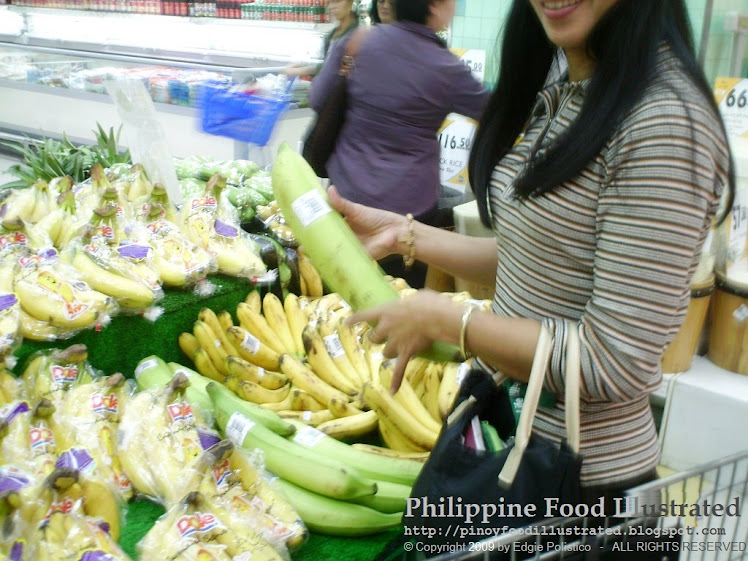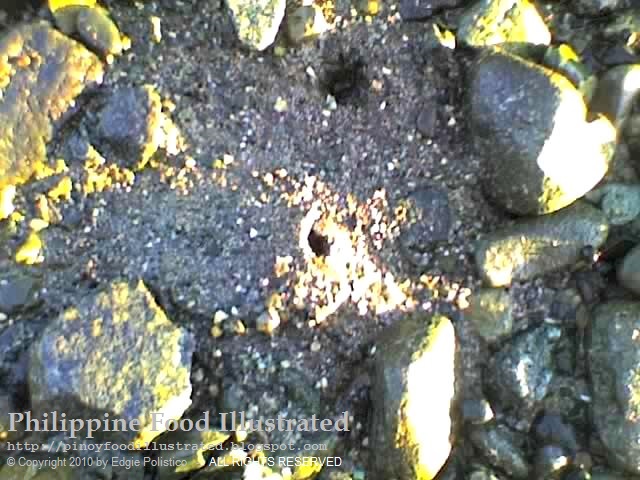tindok - /tin-dok/ (Cebuano fruit) [n.] a giant plantain (sc.name: Musa paradisiaca var. magna).
Other common names
a.k.a. tandok in Cebuano
tenduk or tunduk in Teduray, Lambangian, Dulangan, and Manobo
giant plantain - English
pisang tanduk - Malay (Malaysia)
 |
| We found these few pieces of tindok banana in the grocery section of SM Makati in Ayala Center of Makati City way back in 2009. |
A very long and large variety of cooking banana fruit.
Its digit is about a foot long or more or about the size of a man's arm. Elongated and commonly a bit curved in form with a thick green banana peel.
| The length and size of this banana are even more than that of Margette's arm. |
 |
| Yes, the one she is holding weighs more than a kilo, and it is priced quite expensive in 2009. The sticker says it is from Dole, a clue that most likely this came from Mindanao. |
The tindok plant bears a bunch of fruit that only has around three clusters (piling, sipi, or hand of bananas) in a bunch (buwig) with very few to less than a dozen of digits (daliri or piraso) in each cluster. The bunch would start to sprout at the tip of the banana stem as one big inflorescence (puso ng saging) and would open to bloom only once to produce a few to several digits. Afterward, there will be no more inflorescence (puso) hanging at the end of the bunch. Thus, it also called as "saging na walang puso" (banana with no hanging flower).
Tindok fruit is rich in potassium and starch and is only good when cooked. Green tindok (unripe) is commonly steamed or boiled with its peel intact. When cooked, it is peeled and eaten as a substitute for rice as the main source of carbs or starch.
The pulp of unripe tindok can also be sliced thinly and deep-fried into chips.
Chunks of rare ripe or ripe tindok can also be added as vegetables in boiled bulalo or nilaga similar to saba banana.
Others would have the tindok fruit grilled or broiled, usually sliced lengthwise and served with a spread of peanut butter, fruit jams, or margarine sprinkled with sugar (or press on a bed of sugar).
Below are photos of tindok posted by my friends on Facebook and they are worth sharing here:
 |
| A trunk of tindok with a bunch of giant fruits - photo credit to Aveen Acuna-Gulo's FB account |
 |
This one is captioned with "Per Datu Leticio Datuwata, some fruits grow to be 4 inches in diameter - photo credit to Aveen Acuna-Gulo's FB account |
 |
A pile of tindok at the Bagsakan, Valencia Public Market, Valencia City, Bukidnon - photo credit to Aveen Acuna-Gulo's FB account |
 |
A bunch of tindok by Child Andrade Peteros of Hindang, Leyte - photo credit to Child Andrade Peteros' FB account
This giant plantain is commonly grown in Southeast Asian countries, and can also be seen now, though rarely, in Africa, South America, Central America, and the Caribbean.
Tindok is not a giant lakatan. Jiggy Manicad of Unang Balita (GMA News Online) mistook tindok as giant lakatan in his June 5, 2015 news report "Puno ng saging sa Bulacan, nagbunga ng 'giant lakatan'

Related post:

All photos by Edgie Polistico in this blog are copyrighted. ALL RIGHTS RESERVED.
For more about Filipino food, see this Philippine Food, Cooking, and Dining Dictionary. It is OPEN and FREE.







